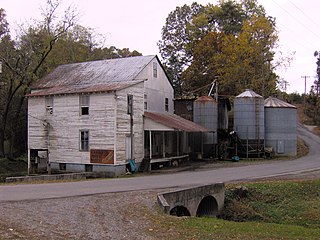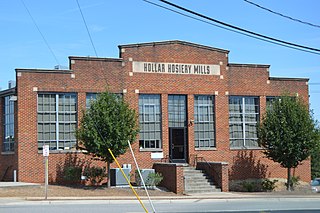
Hanes and Hanes Her Way is a brand of clothing.

The North Carolina School for the Deaf (NCSD) is a state-supported residential school for deaf children established in 1894, in Morganton, North Carolina, US.

The Clover Hill Mill is a gristmill located in the U.S. city of Maryville, Tennessee. Out of the hundreds of early-20th century mills once scattered across the mountains of East Tennessee, the Clover Hill Mill is one of the few still in operation, and the last such full service mill in Blount County. The mill was added to the National Register of Historic Places in 1989.

The Lansdale Silk Hosiery Compy-Interstate Hosiery Mills, Inc. is an historic American silk mill complex located in Lansdale, Montgomery County, Pennsylvania.
Richard Carlyle von Biberstein was an American architect who designed numerous textile mills. Several of his works are listed on the U.S. National Register of Historic Places.

Mock, Judson, Voehringer Company Hosiery Mill, also known as MoJud Hosiery Company and Rolane Factory Outlet Store, is a former hosiery production plant located at 2610 Oakland Avenue in Greensboro, Guilford County, North Carolina. The company was founded in 1926, and operated until 1972. The plant was then shut down, except for a small portion used as an outlet store, until its final complete shutdown in 1999. The plant was listed on the National Register of Historic Places in 2011.
The Oneida Cotton Mills and Scott-Mebane Manufacturing Company Complex, also known as the Scott and Donnell Mill, is a historic hosiery mill building in Graham, Alamance County, North Carolina. It consists of four contributing buildings and one contributing structure. The buildings date from 1882 into the 1940s; all are red-brick except for a small shed-roofed bathroom building from the 1940s. The complex includes the Scott and Donnell Mill, a smokestack (1882), Holt Mill, Scott-Mebane Manufacturing Company, and opener Room.

South King Street Historic District is a national historic district located at Morganton, Burke County, North Carolina. It encompasses 10 contributing buildings in Morganton. It includes residential, religious, and educational buildings built between about 1893 and 1939. It includes representative examples of Colonial Revival, Georgian Revival, and Gothic Revival style architecture. Notable buildings include the Grace Episcopal Church, Morganton Library, and Works Progress Administration constructed nurses' home.

Morganton Downtown Historic District is a national historic district located at Morganton, Burke County, North Carolina. It encompasses 62 contributing buildings in the central business district of Morganton. It includes commercial, industrial, and governmental buildings built between about 1889 and 1940. It includes representative examples of Classical Revival, Art Deco, and Italianate style architecture. Notable buildings include the Old Burke County Courthouse, Morganton Post Office, and the Morganton Community House.
Dunavant Cotton Manufacturing Company, also known as Alpine Cotton Mill No. 1, is a historic cotton mill located at Morganton, Burke County, North Carolina. It is a two-story, brick-clad, side gable-roofed building. The original section was built in 1888–1910, with additions and expansions through 1966. The additions to the building, made in the mid to late 1960s were removed in 2012 to reveal the original 1888-1910 mill building. It is the oldest cotton textile mill in Morganton, and was in use as a cotton textile mill until 1949.

Lenoir Downtown Historic District is a national historic district located at Lenoir, Caldwell County, North Carolina. The district includes 41 contributing buildings and 2 contributing objects in the central business district of Lenoir. It includes commercial, governmental, and institutional buildings in a variety of popular architectural styles including Art Deco, Art Moderne, Classical Revival and Tudor Revival. Notable contributing resources include the Center Theater (1941), O. P. Lutz Furniture Company and Lutz Hosiery Mill (1939), Dayvault's Drug Store (1937), Caldwell County Agricultural Building (1937), Courtney Warehouse, Masonic Hall, Miller Building, Confederate Monument (1910), Belk's Department Store (1928), Lenoir Building (1907), J. C. Penney Department Store, Fidelity Building (1928), and U. S. Post Office (1931). Located in the district is the separately listed Caldwell County Courthouse.

The Lyerly Full Fashioned Mill is a historic hosiery mill located in Hickory, Catawba County, North Carolina. It was built in two stages between 1930 and 1934, and is a two-story, rectangular, nine-by-twelve bay brick building. It features a Moderne-Style 2 1/2-story stair tower. The mill remained in operation until 1957, after which the building was used as a warehouse for a number of years.

Hollar Hosiery Mills-Knit Sox Knitting Mills is a historic knitting mill located at Hickory, Catawba County, North Carolina. It consists of two mill brick manufacturing buildings and a boiler house that were connected by a hyphen in the mid-1960s. The first mill building was built about 1930, and is a one- to two-story, 16 bay, brick veneer structure. The boiler house was also built about 1930, and is a small, brick building, with its flat roof and terra cotta coping. The hosiery yarn mill was built about 1940, and is two-story, six bay by 10 bay, brick-veneered building. Both mill buildings feature banks of steel-sash factory windows. The knitting mill operated until 1968.

Durham Hosiery Mill is a historic textile mill complex located at Durham, Durham County, North Carolina. It includes seven contributing brick buildings in the complex. The original Durham Hosiery Mill was built in 1902, and consists of a four-story main building with a six-story Romanesque Revival-style tower in front; engine, boiler, and heater houses attached at the rear, and a one-story dye house. The main building was expanded with a two-story annex in 1904, and a three-story annex in 1906. Other buildings include the triangular Annex No. 1 (1912) and a three-story brick finishing building. By 1910, the Durham Hosiery Mills Corporation was the largest manufacturer of cotton hosiery in the world. The mill was abandoned in 1922.

P.H. Hanes Knitting Company is a historic textile mill complex located at Winston-Salem, Forsyth County, North Carolina. The complex includes three buildings. The Knitting Building or North Building was built in 1920–1921, and is a six-story, Beaux-Arts style concrete and steel building sheathed in brick. The Mill Building or East Building was built in 1928, and is a five-story-plus-basement building of concrete, brick, and steel construction. The Warehouse and Shipping Building was built in 1940, and is a six-story steel frame building sheathed in brick. The P.H. Hanes Knitting Company was founded in 1901 by Pleasant H. Hanes, brother of John W. Hanes who founded Shamrock Mills, later Hanes Hosiery. In February 1965, P. H. Hanes Knitting Company merged with Hanes Hosiery. The downtown mill complex closed in 1965. The complex has been converted to loft apartments.

Asheboro Hosiery Mills and Cranford Furniture Company Complex, also known as Cranford Industries and National Chair Company, is a historic textile mill and furniture factory complex located at Asheboro, Randolph County, North Carolina. The complex includes three brick industrial buildings erected from 1917 through the 1940s and the Cranford Industries Office, constructed in 1925. Also on the property are the contributing Cranford Industries Smokestack built in the 1950s and a lumber shed erected in the late-1950s.

Acme-McCrary Hosiery Mills, also known as Acme Hosiery Mills, McCrary Hosiery Mills, and Asheboro Grocery Company, is a historic textile mill complex located at Asheboro, Randolph County, North Carolina. The complex includes six buildings and a smokestack, erected between 1909 and 1962. The mill buildings were designed by architect Richard C. Biberstein and the oldest section is a two-story, heavy-timber-frame mill with load bearing brick walls. The Acme-McCrary-Sapona Recreation Center was built in 1948–1949, and is a two-story, Art Moderne style brick recreation center. The buildings were added to the National Register of Historic Places in 2014.

The Winsted Hosiery Mill, also known as the Whiting Mill, is an industrial complex at 210 Holabird Avenue in the Winsted section of Winchester, Connecticut. Developed in the late 19th and early 20th centuries, it was one of the largest industrial employers in the community for many years, and is relatively unaltered from its period of development. It was listed on the National Register of Historic Places in 1985. It is now subdivided for multiple industrial and commercial tenants.

May Hosiery Mills Knitting Mill is a historic building that was built as an early 20th-century hosiery knitting mill in Burlington, Alamance County, North Carolina. Built in 1928, it is listed on the National Register of Historic Places.





















